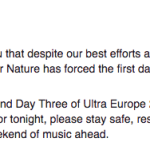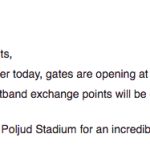April 29, 2020 – How will concerts look after corona? And will Ultra Europe go on? A closer look at the entertainment industry in Croatia.
“The government of the Republic of Croatia could and should show goodwill for the controlled but urgent return of music to both terraces and concert venues,” Croatian musicians said.
Slobodna Dalmacija writes that for this reason, the Croatian Music Association ‘Unison’ sent a letter to the Government, the Civil Protection Headquarters, and the Croatian Institute of Public Health, with five proposed models for the return of live music performances.
“Opening music studios for recording and production, concerts on terraces and open spaces such as squares and waterfronts, drive-in concerts, indoor and open-air concerts,” is a list of proposals by Unison. This umbrella band brings together associations of composers, performers and their services for the collective exercise of copyright and performing rights. With the implementation of the proposed models, 17,000 people – music creatives and their families – would again be able to return to pre-pandemic coronavirus status.
At present, there are approximately 5,000 writers, 10,000 performers, and approximately 2,000 supporting musicians and technical staff involved in the concert and performing activities in Croatia. Live music, Unison points out, has seen a huge drop in business, but also a drop in revenue by one hundred percent over normal conditions. Therefore, musicians must return to performing as quickly as possible and in customized operating conditions for the following weeks and months.
Music creatives and all those whose jobs are related to the industry are calling to join the first wave of relaxation measures, Unison said, as restrictive public gathering measures have hit the music and cultural community first and foremost in the past six weeks. At first, for security reasons, as live performances on terraces, concerts and stadiums were canceled and banned, followed by measures for all other branches of the economy.
What will the live performances look like in the life that follows the coronavirus pandemic?
First of all, they believe that music and film studios for recording and production should be open, since recording at home and semi-professional or amateur quality cannot permanently replace the professional mode and the required studio quality of production.
“The current mode may meet the market’s need for new works in the short term, but it will soon be saturated with such products because this mode has no economic or financial impact for participants,” Unison said, noting that it could immediately start recording with 2-3 people in the studio, from May 11, and those with multiple members (up to 10 people), and from May 18, with orchestras and choirs.
According to the instructions of the Civil Protection Headquarters, which stated the possibility of opening terraces at hotels and catering facilities for the needs of domestic and possibly foreign tourists, the possibility of holding concert performances of bands should be approved from May 11 (or from the moment of their opening) and DJs (for simpler technical needs for music production) in such venues. Musicians, they believe, could also perform concerts in squares or waterfronts in tourist sites, with mandatory adherence to space, defined by the positions in front of the stage, and epidemiological measures.
Similar to the principle of religious services, musicians have been demanding, from May 4, that concerts be held indoors during which it is possible to ensure mutual physical distance while respecting epidemiological guidelines.
They suggest the ability to hold concerts with a limited number of visitors up to 150 (separated by space tags – flags, stickers on the floor, ribbons …) or by seating, which would be held in substantially larger spaces, with a usual capacity of 300 visitors upwards. They propose the same for larger spaces, which can accommodate 200 to 2000 people under standard conditions, and now the maximum number of visitors would be 150 per event.
Starting May 18, they would also like to have the opportunity to host major concert events (for more than 150 visitors) in large concert venues such as gyms and similar venues that otherwise have a capacity of 2000 people upwards.
For the summer of 2020 (from June onwards), it is proposed to return to open-air concerts such as Ultra Europe in Split, where audiences would attend concerts in groups of five or ten people in large and open areas. Service and hygiene activities could be conducted on a line-by-trade basis, respecting all epidemiological measures.
The official website of the Ultra Europe Festival, scheduled for July 10, 11, and 12 at the Split Park Mladezi, is just 73 days away, which has brought party-goers from all over the world to Split in recent years. This is a type of music event associated with large sponsors because of production costs, but also because of larger audiences. Few believe that it will take place.
However, the organizers of Ultra are reluctant to make an official announcement yet – and have not canceled its July release, as have most other summer festivals. Everyone is off to a slow start, waiting for when and to what extent restrictions will be eased. Some European countries have already given new guidelines. For example, in Norway, until September 2, the ban on all public events with more than 500 spectators has been extended.
This uncertainty also plagues the director of the Split Festival, Tomislav Mrduljaš, who is preparing the jubilee, 60th edition of the Split Festival. It is scheduled to take place July 2-4 at Prokurative.
“I am waiting for what will happen with the new measures … I have not canceled anything yet, the competition for songs is ongoing, we will decide in early May. As far as I’m concerned, I have the whole structure and organization of the festival set up, so it won’t be a problem to hold it,” Mrduljaš said. “The new, looser measures would be one light at the end of the tunnel. For the sake of cheering people up a little… The festival is held in the open, I think something could be done here,” said Mrduljaš.
To read more about lifestyle in Croatia, follow TCN’s dedicated page.











